Remote Work Statistics By Region, Productivity, Challenges, Impact And Trend (2025)
Updated · Nov 04, 2025
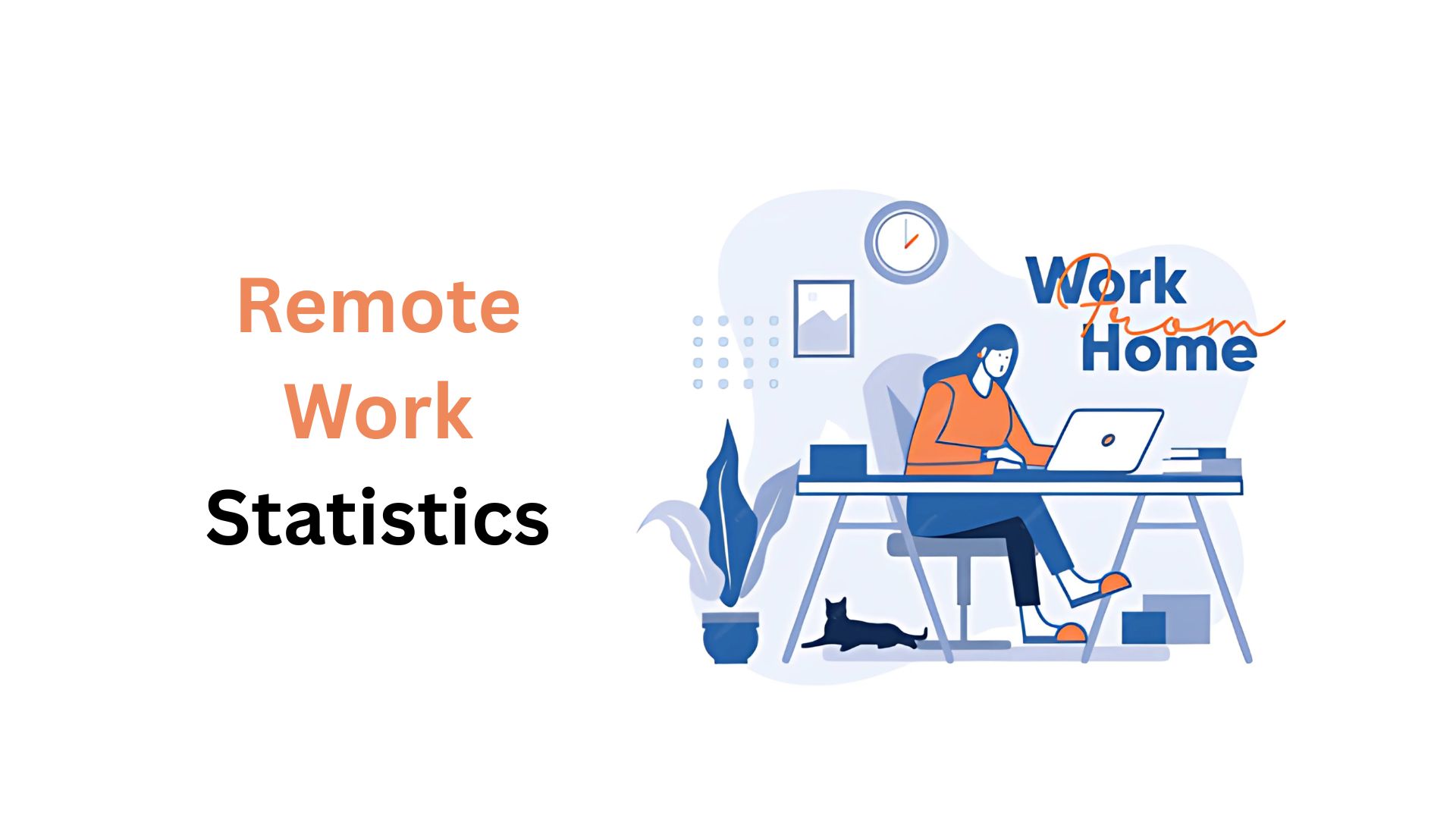
Table of Contents
Introduction
Remote Work Statistics: Let’s be honest. A few years ago, most of us thought remote work was a temporary solution, a phase that would fade as things got back to “normal”. But fast forward to today, and remote work has become one of the biggest shifts the job market has ever seen. I’m in full-time remote work, and the one who is reading this might also be working remotely. What started as a backup plan has now turned into a new standard, with millions of people choosing flexibility over the traditional 9 5 office life.
In this article, I want to walk you through the real story, not just opinions, but actual numbers that show how much the world of work has changed. These remote work statistics will give you a clear picture of where things stand right now, what’s working, what’s not, and where it’s all headed. From how many people are working remotely to how much companies are saving yearly, the mental health concerns, and even the rise of digital employees, we’re going deep into the data.
Whether you’re a remote worker yourself, a business owner rethinking your policies, or just curious about how this shift is shaping the world, this is the kind of report that lays everything on the table. So let’s break it down one by one.
Editor’s Choice
- 22% of the U.S. workforce, around 32 to 36 million people, is now working remotely as of 2025, which is nearly five times more than in 2019.
- 40% of all new job listings in the U.S. offer remote or hybrid work options, showing just how far we’ve come from rigid office roles.
- Hybrid job roles grew from 9% to 24% between 2023 and 2025, while fully remote roles increased from 10% to 13% during the same period.
- Remote workers are showing 13% to 47% higher productivity, saving employers thousands per employee every year.
- Each remote worker contributes an average of $3,900 to $13,8000 more in annual value compared to fully in-office workers.
- Cybersecurity breaches from remote setups cost an average of $350,000 per incident, which is significantly higher than office-based breaches.
- 45% of remote employees feel isolated, and 28% work an average of two hours extra daily.
- S. employers save over $30 billion annually from remote work in real estate, operations, and maintenance expenses.
- Remote workers themselves save an average of $2,000 per year, adding up to a total savings of $90 billion
- The remote work software market is booming, projected to grow from $31.7 billion to $97.5 billion by 2032.
- 56% of companies plan to integrate AI-powered tools into their remote work stack by 2026, showing how tech is shaping the future of flexibility.
- The digital people population is expected to hit 35 million globally by 2028, proving that the remote-first lifestyle is going mainstream.
| Insight | Figure / Data |
| Share of the U.S. workforce working remotely in 2025 |
22% about 32 to 36 million workers, up from 4% in 2019 |
|
Job postings offering remote options in 2025 Q1 |
40% in 4 in 10 listings, up from 13% in 2020 |
| Growth in hybrid vs fully remote roles in the U.S. |
Hybrid 9% to 24%, fully remote 10% to 13% in 2023 to 2025 |
|
Productivity gains seen in remote setups |
+13% to 47% per worker, equating to $ 3.9K to 13.8K value |
| Remote-related cybersecurity breach cost |
$350K per incident, compared to $210K onsite |
|
Employee reported loneliness and overtime average |
45% feel isolated; 28% work +2 hours per day |
| Estimated annual employer cost savings from remote work in the U.S. |
$30 billion |
|
Employee savings from remote work |
$90 billion collectively, $2K per person |
| Global remote work software & services market growth |
$31.7 b to $97.5 b by 2032 |
|
Companies planning AI-integrated remote tools by 2026 |
56% |
Global Remote Work Trend
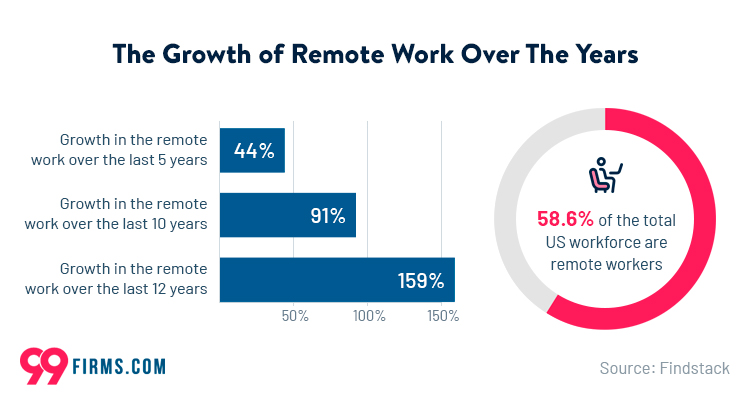
- 22% of the U.S. workforce, about 32.6 to 36.2 million people, is working remotely in 2025, a sharp increase from just 4.1% in 2019. That’s around a fivefold jump since before the pandemic.
- Over 15% of new U.S. job postings are now remote roles, three times the number from 2020, signaling how remote work has become the new norm.
- By Q1 2025, 24% of new job postings will allow at least some remote work, reflecting strong employer flexibility in hiring.
- In Q1 2025, 4 in 10 U.S. job postings allow at least some remote work, reflecting strong employer flexibility in hiring.
- Globally, 50% of workers report hybrid models, 30% fully remote, and just 20% are onsite only, showing the gradual shift to hybrid-first work cultures.
- In the U.S., workers average 1.5 to 2 remote days per week, while in Asia, the average is closer to 0.5 to 1 day, highlighting geographic differences.
- Digital people in the U.S. grew 131%, from 17.3 million in 2023 to 18.1 million in 2024, underlining the growth of location-independent work.
- 69% of U.S. companies now offer flexible work arrangements, up from just over 50% the year before.
- Small businesses are adapting fast: 73% of businesses under 500 employees now have fully flexible work policies.
- Fully remote roles plateaued at around 13% suggesting a stable long-term demand for remote-first positions.
| Metric | 2023 Stat | 2025 Figures |
| Remote-capable workforce in the U.S. | 4.1% about 5.7M | 22% in 32m to 36m |
| New hybrid roles in the U.S. | 9% of postings | 24% of postings |
| New fully remote roles in the U.S. | 10% | 13% |
| Job postings permitting remote/hybrid work | N/A | 40% in 4 in 10 jobs |
| Worker preference globally in Hy/Rem/Onsite | N/A | 50/30/20 split |
| Digital nomad count in the U.S. | 17.3m | 18.1M about +131% vs. 2019 |
Productivity, Well-Being, and Retention in Remote Work
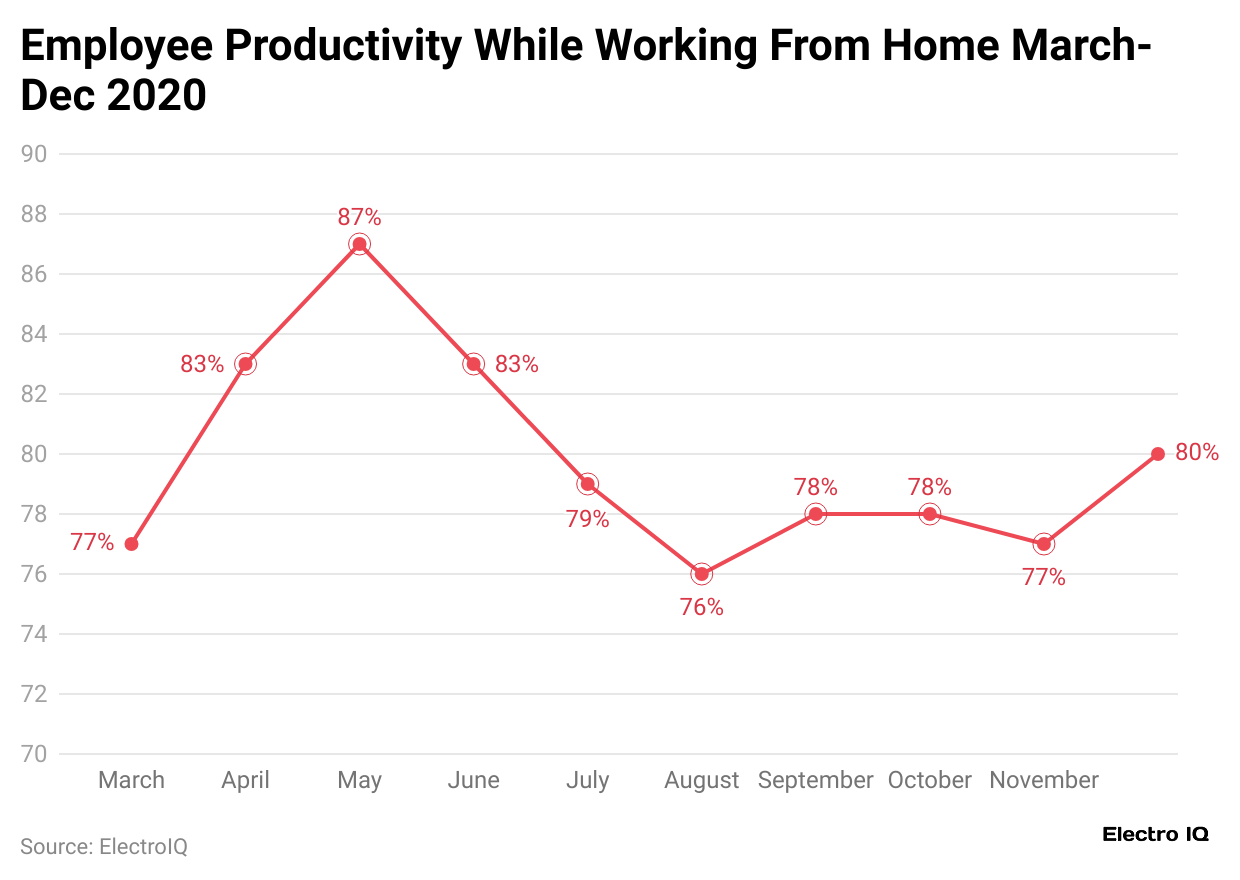
- 68% of remote workers say they get as much or more done in the same or less time than in the office, thanks to focus time and fewer interruptions.
- 84% of hybrid or remote employees report feeling more productive than when working onsite full-time.
- A Stanford study of 16,000 employees found a 13% increase in productivity when working from home, while other reports have shown up to 47% productivity gains.
- Remote workers also average an extra 10 minutes per day of productive time and 1 extra workday per month, suggesting hidden gains in capacity.
- However, 60% of managers say it’s harder to evaluate remote employee performance, highlighting monitoring challenges.
- Fully remote employees show the highest engagement: 31% engaged, compared with 23% in hybrid roles and only 19% for non-remote-capable roles.
- Mental well-being stats show 36% of fully remote workers are “thriving”, slightly below hybrid, about 42% but ahead og fully onsite employees, about 30%.
- Yet remote workers report more distress: 45% felt stressed the previous day, compared to 38 to 39% of onsite employees.
- Better work-life balance is reported by 75% of remote workers, while 50 to 60% would quit if forced back to full-time office work.
- Eliminating commuting frees up about 55 minutes daily, adding time for work, rest, ot family, while reducing stress and carbon footprint.
| Metric | Remote Benefit | Onsite Comparison |
| Same/greater productivity | 68% of remote workers | N/A |
| Reported increased productivity | 84% in (hybrid/remote combined) | N/A |
| Measured productivity gain | +13% to 47% | Office baseline |
| Extra productive time per day | +10 minutes | N/A |
| More work days per month | +1 day | N/A |
| Manager monitoring difficulty | 60% say harder | N/A |
| Employee engagement | Fully remote 31%, hybrid 23%, onsite 19% | N/A |
| Wee-being thriving | Remote 36%, hybrid 23%, onsite 30% | N/A |
| Recent stress (%) | Remote 45%, hybrid 46%, onsite 38 to 39% | N/A |
| Better work-life balance | 75% | N/A |
| Risk of quitting if full-time office | 50 to 60% | N/A |
| Daily commute time saved | 55 minutes | N/A |
Organizational Adoption, Policies, and Trends
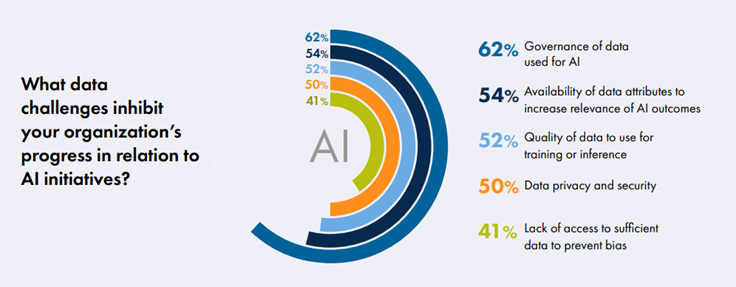
- 69% of U.S. companies offer hybrid or remote options in 2025, a shift from around 51% in 2024, showing rapid policy adoption.
- 73% of small businesses with under 500 employees now operate flexible work models, showing adaptability in smaller organizations.
- The U.S. GAO reported that fully remote roles saw a 12% performance boost in roles with clear metrics, like case handling in public sector work.
- Federal agencies saved over $180 million in real estate costs in one year, and remote work eligibility reached 50% of federal employees in 2020.
- In Australia, 61.6% support 1 to 4 remote days weekly, while only 28.8% prefer full-time onsite, underscoring the preference for hybrid models.
- The UK leads Europe: workers average 1.8 remote days weekly, surpassing the global average of 1.3 days per week.
- CEOs expect increased office returns by 2027, but 58% of UK employees say they’ll quit if required to work full-time in the office.
- California and Texas recently reversed remote policies, requiring office attendance 4 to 5 days/week, sparking concern over hiring and retention.
- Across 27 sampled companies, 85% allow hybris working with a typical 3 days in the office per week mandated.
- About 32.4% of Australians say they’re more productive at home today, up from 29% in 2023, reflecting growing home-working efficiency.
| Insight | Figure & Trend |
| Companies offering remote/hybrid work in the U.S. | 69% in 2025 vs 51% in 2024 |
| Small businesses with flexible models | 73% |
| GAO productivity gain in remote roles | +12% performance uplift |
| Federal agency real estate savings | $180M+ annually |
| Federal workers are eligible to work remotely | 50% |
| Australian support for hybrid work | 61.6% favor 1 to 4 remote days/week |
| UK average remote days per week | 1.8 days vs global 1.3 |
| UK remote-workers quitting vs mandate | 58% would quit if forced onsite |
| Policy reversal states (CA, TX) | Mandated 4 to 5 on-site days/week |
| Companies with hybrid mandates (3/5days) | 85% of sampled firms |
| Australian remote productivity gain | 32.4% feel more productive (vs 29%) |
Remote Work Challenges and Cybersecurity Risks
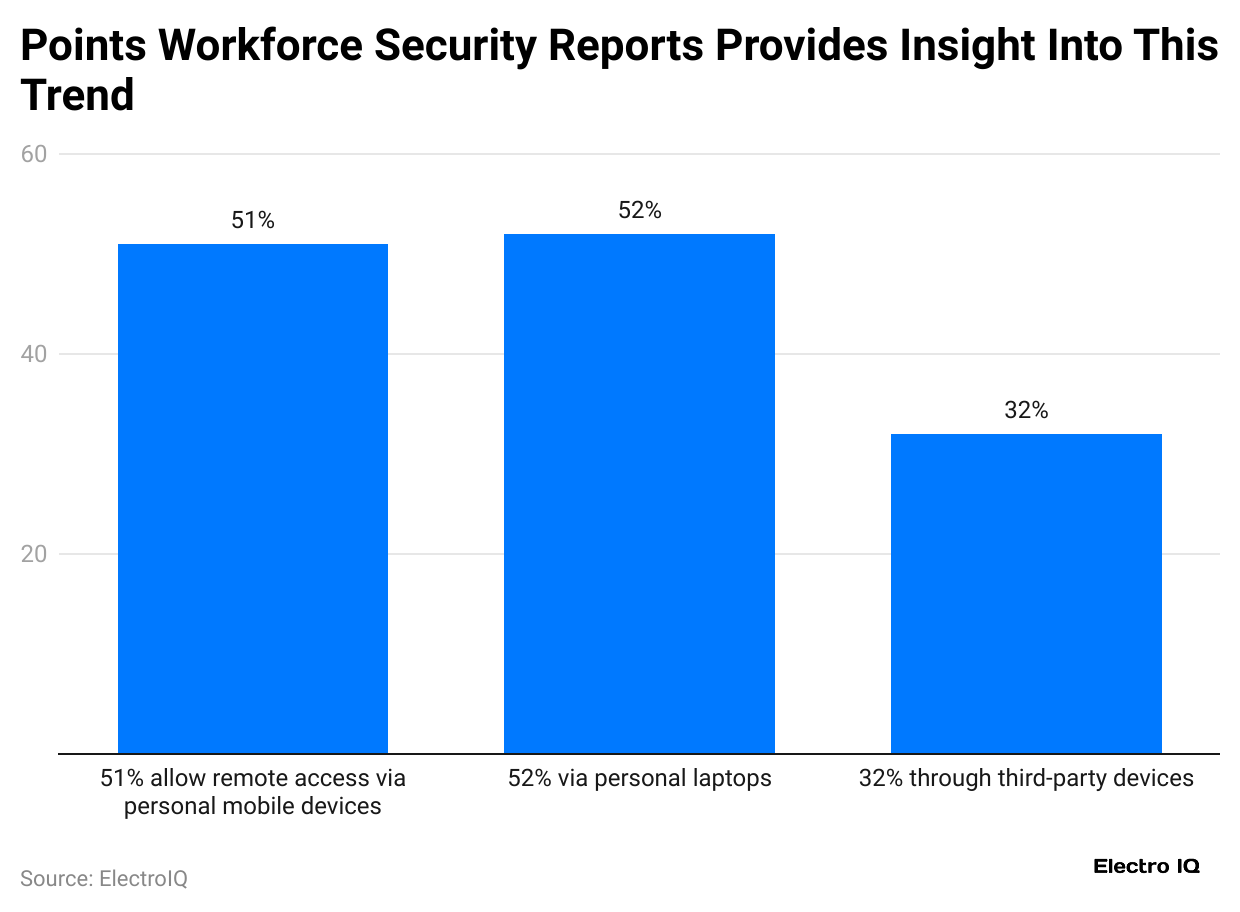
- 45% of remote workers report feeling isolated or lonely, indicating mental health as a rising concern outside of traditional office communities.
- 28% admit to working longer hours remotely, with an average of 2 extra hours per day, increasing burnout risk.
- 60% of managers struggle with performance management remotely, citing a lack of visibility into daily tasks as the main barrier.
- 41% of IT teams have experienced a security incident tied to a remote device, malware, phishing, or unsecured Wi-Fi.
- 85% of companies now require multi-factor authentication (MFA) for remote access, up from 60% in 2022, showing an increased response to risk.
- Remote workstation breaches cost companies on average $350,000 per incident, compared to $210,000 for office-based breaches.
- 43% of workers use personal devices, and only 55% of those devices meet corporate security standards, posing hidden vulnerabilities.
- VPN usage grew 30% in 2024 as more companies enforce secure remote network connections, though many users still bypass VPNs.
- Over 20% of phishing attacks now prey on remote workers, who are over 2.5 times likelier to click suspicious links than in-office employees.
- Cyber training compliance is now mandatory for 89% of remote staff, compared with just 70% for in-office workers, reflecting higher vigilance.
| Issue | Data / Figure | Trend / Impact |
| Isolation & loneliness | 45% of remote workers | Mental health concern |
| Work hours extended | +2 hours/day for 28% | Burnout risk increasing |
| Managerial oversight difficulty | 60% of managers | Supervisory challenge in a remote setup |
| Security incidents via remote | 41% of IT teams reported | Includes malware and insecure Wi-Fi |
| MFA enforcement growth | 85% usage now | Up from 60% in 2022 |
| Remote breach cost | $350K per incident | Higher cost vs. in-office breaches |
| Use of personal devices | 43% of staff | Security concerns: nearly half are non-compliant |
| VPN adoption | +30% growth in 2024 | Some bypass remains a problem |
| Phishing attack target | 20% of enterprise incidents | Remote workers are 2.5x more likely to click |
| Cyber training compliance | 89% of remote staff | Compared to 70% for onsite |
Economic Impact and Cost Savings
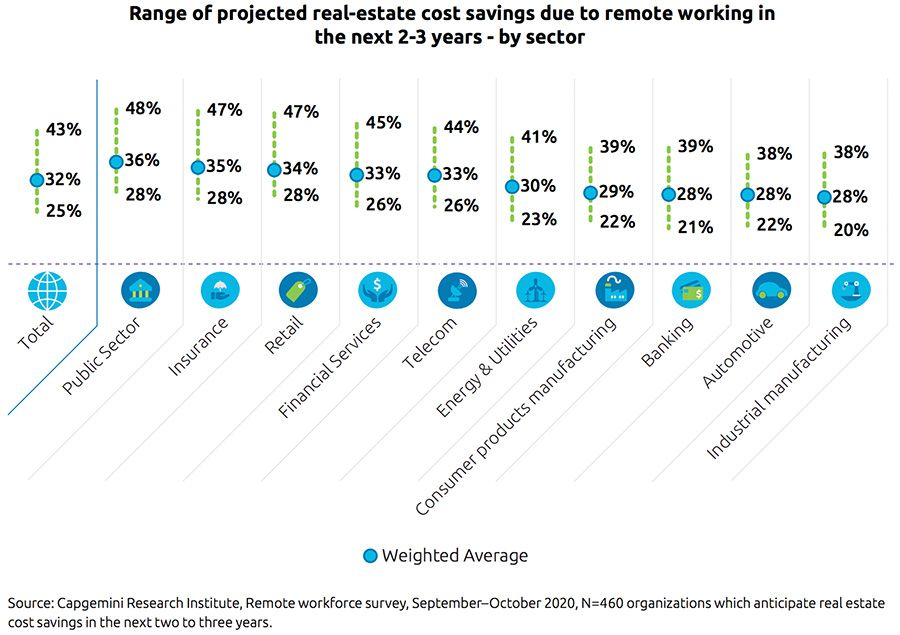
- Remote work has saved U.S. employers around $30 billion per year in reduced real estate and utility costs combined.
- Employees collectively save nearly $90 billion annually in travel, meals, and work attire, averaging $2,000 per remote worker.
- By allowing remote work, companies report 10 to 20% lower turnover, translating to a yearly talent retention savings of $5,000 to $10,000 per employee.
- Federal remote work saved $180 million in just one year, enabling hiring freezes and repurposing of office spaces.
- Small businesses achieve 20 to 35% higher profit margins when they maintain hybrid-flex policies, driven by lower premises expenses.
- In the U.K., average office space per person dropped from 150 to 95 sqft, reflecting significant space efficiencies.
- Global cost savings from remote work practices surpassed $300 billion in 2024, covering both business and personal domains.
- Productivity gains of 13 to 47% translate to the potential annual equivalent of $3,900 to 13,800 per remote worker.
- Annual carbon emission reduction from remote work tallies to 44 million tonnes CO2, comparable to taking 9 million cars off the road.
- The gig and freelance economy expanded by 45% between 2020 and 2024, supported by global remote infrastructure growth.
| Economic Metric | Value / Benefit | Scope |
| Employer cost savings in the U.S. | $30 billion/year | Real estate and facilities |
| Employee savings | $90 billion/year | Travel, meal, wardrobe |
| Talent retention benefits | $5 to 10K per employee | 10 to 20% turnover reduction |
| U.S. federal outsourcing savings | $180 million/year | Real estate reallocation |
| SMB profit margin increases | +20 to 35% | Small business cost advantage |
| Office space efficiency UK | 150 to 95 sq ft per person | Workplace densification |
| Global cost reduction | $300B+ by 2024 | Business and personal benefits |
| Productivity value-add per worker | $3.9K to 13.8K annually | Based on 13 to 47% gains |
| Emission reduction impact | 44 million tonnes CO2 saved | Environmental advantage |
| Gig economy growth | +45% (2020 – 2024) | Enabled by remote infrastructure |
Future Outlook and Growth Projections
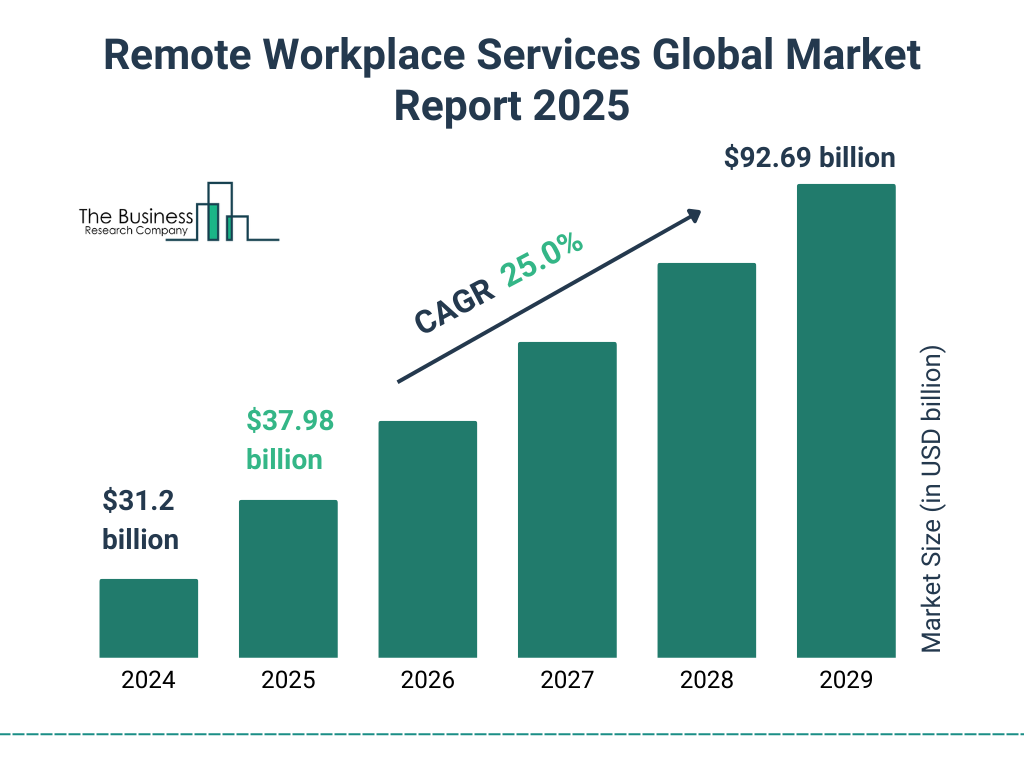
- The global remote work software and services market is projected to grow from $31.7 billion in 2024 to $97.5 billion by 2032, with a CAGR of approximately 14%.
- Fully remote roles are expected to slowly increase by 14 to 16% of all job postings by 2027, while hybrid roles dominate at a 35 to 40% share.
- By 2028, the digital nomad population is expected to reach 35 million, reflecting sustained remote-first hiring and lifestyle expansion.
- Remote work adaptation across emerging markets is expanding: In India, remote-capable roles rose from 7% in 2021 to 19% in 2025.
- Five-year forecasts show $12.5 billion investment in remote infrastructure across 20 major global metros.
- CEO surveys indicate 73% plan to adopt remote-first practices by 2027, vs 39% today, signaling major policy transformation.
- AI adoption in remote tools is surging: 56% of companies plan to integrate AI-driven productivity features by 2026.
- Educational institutions are expanding remote training: 65% of courses now offer at least one online module, up from 45% in 2022.
- Cybersecurity investment for remote setups is projected to grow from $7.2 billion in 2024 to $15.8 billion by 2028, due to rising threats.
- Global workplace emissions are forecast to fall by an additional 30% if remote policies get further adoption by 2028.
| Outlook Factor | Projection by Target Year | Context |
| Remote work software market | $31.7B to 97.5B by 2032 | Tech and services growth |
| Fully remote roles in the job market | 14 to 16% by 2027 | Minor gains; hybrid dominates |
| Digital nomad population | Expected 35M by 2028 | Remote lifestyle mainstreaming |
| India’s remote work expansion | 7% to 19% remote roles (2021 to 2025) | Emerging market adapts |
| Global remote infrastructure | $12.5B investment in 5 years | Capex in metro workplaces |
| Enterprise remote adoption | 73% of CEOs by 2027 | Strategic policy shift |
| AI integration in remote tools | 56% plan by 2026 | Boosting productivity shift |
| Online education shift | 45% to 65% hybrid modules from 2022 to now | Academic adaption |
| Remote cybersecurity spend | $7.2B to 15.8B by 2028 | Cyber defense budget expansion |
| Emission reduction potential | An additional 30% CO2 drop by 2028 | Environmental benefit amplification |
Conclusion
After diving into these remote work statistics, the evidence is clear: remote or hybrid work is here to stay. It boosts productivity, cuts costs, and offers flexibility, but not without challenges, from cybersecurity risks to mental health concerns.
These numbers point us toward smarter policies, better tools, and more human-centered ways of working. Because when work is defined by value delivered, not just a physical desk, the rules change for everyone. Thanks for staying up till the end.
Sources
FAQ.
Around 22%, roughly 32–36 million people, nearly five times more than in 2019.
About 40% of postings now permit remote or hybrid work, up sharply from under 15% in early 2020.
Productivity gains range from 13–47%, translating into USD 3.9K–13.8K value per remote employee per year.
Isolation and burnout are serious issues; 45% feel isolated, and 28% work 2+ extra hours daily.
On average, USD 350,000 per breach, compared to USD 210,000 for similar office-based incidents.
U.S. employers save about USD 30 billion per year in real estate, related utilities, and overhead.
Combined savings of USD 90 billion annually, mostly from saved commuting time, meals, clothing, and work-related expenses.
Expected to grow from USD 31.7 billion in 2024 to USD 97.5 billion by 2032.
Hybrid roles could reach 35–40% of all job listings, with fully remote roles settling around 14–16%.
By 2026, 56% of companies plan to use AI-integrated tools; cybersecurity spend for remote setups is expected to double.

Joseph D'Souza founded ElectroIQ in 2010 as a personal project to share his insights and experiences with tech gadgets. Over time, it has grown into a well-regarded tech blog, known for its in-depth technology trends, smartphone reviews and app-related statistics.










